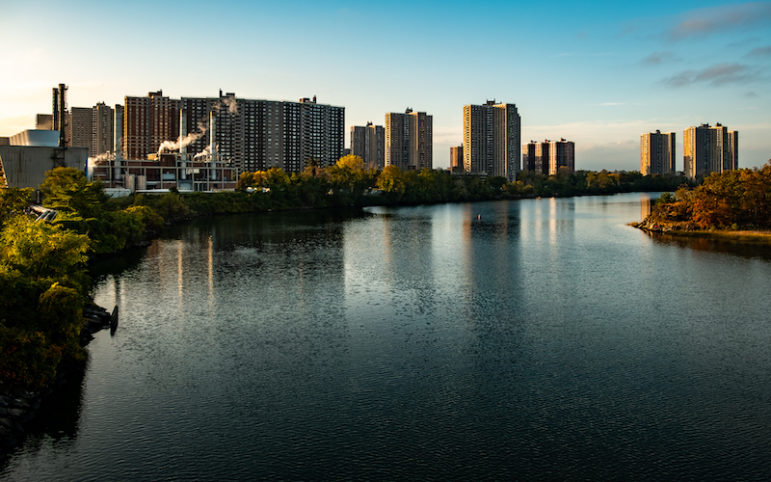President Trump’s cancellation of a Corps of Engineers study means there’s no federal planning underway for protecting New York City from the impacts of global warming. Will that change under a President Biden?

On this day in 2012, New Yorkers were keeping one eye on the presidential election and another on the forecasts coming out of the National Hurricane Center as Hurricane Sandy chugged up the East Coast.
No major storm is forecast for the five boroughs as the 2020 election approaches. Eight years after Sandy delivered a catastrophic blow to the city’s waterfront, however, many are watching the presidential race and Congress for signs that Washington is finally getting serious about protecting places like New York (and New Orleans and Houston) from the inevitable effects of climate change.

“We need the federal government to pool the efforts of different municipalities and state agencies into a coherent plan we can implement to protect our coastline and ecosystem from the ravages of climate change to come,” says Paul Gallay, the president of Riverkeeper. “We need an enormous shift in attitude to protect coastal communities in red and blue states alike. Anyone who has not seen that has their head in the sand and pretty soon they’ll be underwater.”
After the second and final presidential debate, Democratic nominee Joe Biden’s position on fossil fuels took the spotlight. His pledge to eventually move away from oil and natural gas is clearly at odds with President Donald Trump’s approach to climate issues, which has revolved around questioning the science of global warming and erasing Obama-era regulations meant to curb it.
Even if carbon emissions were curbed dramatically and immediately, however, some impact from climate change is inevitable. And Biden’s rhetoric and Trump’s record diverge as sharply on responding to climate change as they do on trying to prevent or reduce it. That difference in philosophy, if translated into action by whoever wins on Nov. 3, could have major implications for New York City, which is uniquely vulnerable not just to the risk of catastrophic coastal storms but also day to day sea-level rise, interior flooding from intense rain events and extreme heat.
Not that this is just a New York thing. The summer’s wildfires were a reminder of the broad geographic and multifaceted threat that climate change could pose. “Overall, the country needs a national resiliency strategy, coastal and inland,” says Cortney Worrall, president and CEO of the Waterfront Alliance.
The president’s record
The desire for such a strategy did not arise since Trump took power. It has existed for many years. Under the current administration, “Not much has changed,” Worrall says. “I don’t think the expectations were very high to begin with.”
What change there has been has not been good. Shortly after taking office, Trump signed a sweeping executive order tearing down much of President Obama’s climate policy. Some of the measures Trump killed were aimed at preventing or mitigating climate change, like Obama’s Clean Power Plan, but others were aimed at preparing for the impact of the climate change that is already in motion.
Among these were a 2013 Obama executive order that required federal agencies to identify “climate change related impacts on and risks to the agency’s ability to accomplish its missions,” a 2016 presidential memorandum that determined climate change “poses a significant and growing threat to national security,” and a guideline requiring agencies to make climate-change considerations part of the policy reviews they do under the National Environmental Policy Act.
Trump’s impact wasn’t just on the federal planning process; his administration also had an effect on the timeline for major infrastructure projects to protect New York City from sea-level rise.
Congress passed and the president signed in early 2019 a measure that included approval for a 5.3-mile seawall to protect the east shore of Staten Island from storm surge and higher tides. (Rep. Max Rose sponsored that legislation, which his Republican predecessor Dan Donovan had also backed.)
However, the Trump administration halted the much larger and more important U.S. Army Corps of Engineers (USACE) study of how to protect the entire New York Harbor from storm surge—a project that had been underway for six years and cost $19 million, and which was on the verge of identifying a strategy for build-out.
A study delayed
Some environmentalists had criticized that study for focusing on storm surge rather than the broader threat of higher seas, and for emphasizing hard infrastructure over natural mitigation measures like wetlands. Yet, warts and all, at least the Corps was working on a plan, and many were shocked that the Trump administration would freeze the only federal effort to protect its largest population center from rising seas.
“It was the only study looking at resilience on a regional level,” says Robert Freudenberg, the Regional Plan Association’s vice president of energy and environmental programs. “Resuming it is a priority.”
Gallay concurs: “That he has shelved [it] with no replacement in sight is criminal.”
Jainey Bavishi, the director of the Mayor’s Office of Resiliency, said the cancellation of the USACE study was “reckless,” and that she is hopeful Biden would restore it. However, since the study would have taken several more months to complete and the Corps’ recommended projects would have taken years to fund and build, the practical impact of Trump’s cancelling the study has been limited.
“We haven’t been waiting for Washington to take action on climate. We’ve been really successful at moving forward in the work we need to do,” Bavishi said, pointing to the projects New York City has undertaken since Sandy to harden infrastructure, improve evacuation planning and build networks to assist in climate emergencies “We’re absolutely safer than we were after Sandy. We’ve made a ton of progress. There’s a lot happening.”
The de Blasio administration has been criticized for focusing its coastal defense work on Manhattan, while other waterfront neighborhoods remain largely defenseless to major storms. However, the administration recently opened public review on a set of coastal zoning regulations for the entire city. “Resiliency is a process, it’s not an outcome. We’ve a lot more to do. I think that we have been able to move forward in a way most cities haven’t been able to,” Bavishi says. “If there had been more support or funding, we would have gone farther, but we have good momentum.”
Biden’s commitment to ‘adaptation’
Biden’s extensive environmental platform promises to adopt a “climate adaptation agenda,” that would create model zoning and building codes to defend against climate impacts, work with the insurance industry to figure out ways to reduce flood-related coverage costs for areas where there’s an investment in resilience, and “create a new class of well-paying jobs and job training around climate resilient industries” such as “coastal restoration, resilient infrastructure design, construction and evaluation.” He also pledges to invest in the resilience of military bases.
Addressing the economic impact of the pandemic will likely be Biden’s first task as president, but advocates see a chance to advance resiliency in that context, too. “What’s really important is that the economic recovery and stimulus dollars go into infrastructure that is resilient,” Worrall says. And it cannot be a short-term thing, says Freudenberg. “At this point there is no ongoing source of funding for resiliency,” he says. “We need new funding streams,” perhaps including a surcharge on insurance premiums.

A major question is whether a President Biden will confront perhaps the most delicate issue when it comes to girding against the inescapable impacts of climate change: the question of whether, and how, to retreat from areas where flooding is going to become severe.
“A significant chunk of our coastline will not be viable places to live,” says Worrall. “This is a really complicated question. It has historical implications, sociological implications, funding implications. It has future use implications.” What’s clear is that waiting until water drives people from those areas is a recipe for economic injustice, since low-income families are less likely to benefit from buyouts or have the flexibility to easily relocate.
There are new policy ideas that might address the issue, like advance commitment buyouts, in which property owners commit to being the last residents of their land. “This is a hard conversation to have but we have time to figure this out,” Freudenberg says.
A new version of the National Flood Insurance Program that better reflected current risks was due to roll out this fall, but has been delayed until 2021. Advocates say the program is an improvement over the current one, but still falls short at addressing the true scope of risk in a way that shields economically vulnerable families from impossible insurance costs.
Even if the insurance policies improve, the maps on which they are are based remain out of date. The Federal Emergency Management Administration proposed an update to New York City’s flood maps in 2015 that the city challenged as inaccurate. New York’s appeal succeeded, and work to correct the maps continues. Final versions are expected no sooner than 2024—and, according to advocates, New York City’s maps are more up-to-date than many other jurisdictions’. The urgency around flood mapping and insurance will only increase if the state legislature moves ahead with a flood-risk disclosure mandate that it has been considering for some time.
Looking to Congress
Biden and Trump are not the only players on this stage. Despite the president’s apparent antipathy to measures that suggest climate change is a real threat, Congress has managed to include appropriations for military climate readiness in recent budgets. Environmentalists are now hoping that Congress passes a reauthorization of the Water Resources Development Act (WRDA)—the law that empowers federal efforts to manage flood risk. A version that passed the House in July includes much that climate advocates like. Senate action comes next. “Right now is Congress’ opportunity to lead,” says Gallay.
The promising shape of the WRDA demonstrates that there is slightly more appetite in Congress for measures to address the impact of climate change than for those to reduce carbon emissions in the hope of avoiding global warming. That’s not a tradeoff that will work for long, but it could provide a chance to get resiliency projects into the pipeline sooner rather than later. “If it’s not done in the context of climate change, I think there is more of an opportunity for those projects,” says Freudenberg. “I’m hopeful but clear-eyed.”








